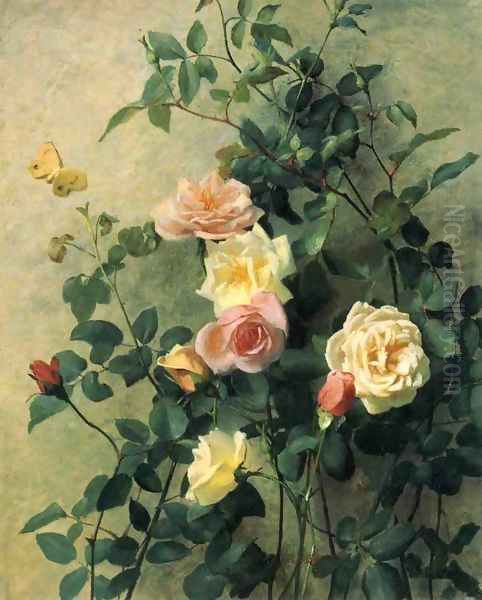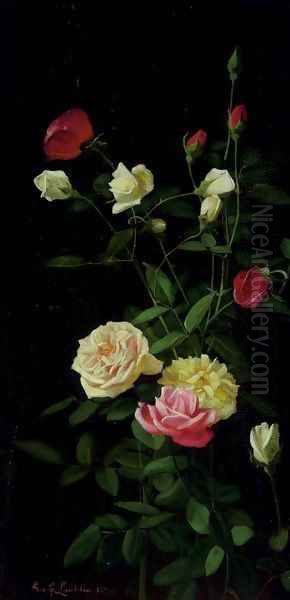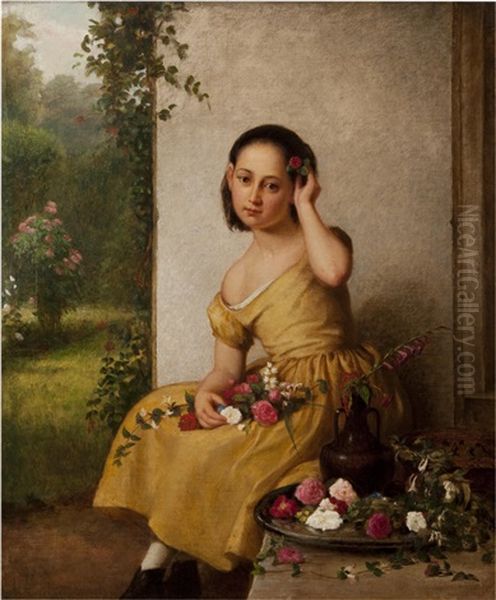George Cochran Lambdin stands as a significant figure in nineteenth-century American art. Born in an era of burgeoning national identity and artistic exploration, he carved a distinct niche for himself, transitioning from poignant genre scenes reflecting the nation's struggles to becoming one of the most celebrated painters of flowers, particularly roses, earning him lasting recognition in the annals of American still life painting. His journey reflects both personal artistic evolution and the broader cultural currents of the Victorian age in the United States.
Early Life and Artistic Foundations
George Cochran Lambdin was born on January 6, 1830, in Pittsburgh, Pennsylvania. His artistic inclinations were likely nurtured from a young age, as he was the son of James Reid Lambdin, a well-regarded portrait painter and miniaturist. The elder Lambdin was a prominent figure in the art communities of Pittsburgh and later Philadelphia, known for his portraits of presidents and other notable figures. This familial connection undoubtedly provided George with early exposure to the world of art and likely his initial training.
The family eventually relocated to Philadelphia, a vibrant center for arts and culture in America at the time. This move proved pivotal for George's development. In 1848, at the age of eighteen, he enrolled at the prestigious Pennsylvania Academy of the Fine Arts (PAFA), the oldest art museum and school in the United States. This institution would become central to his career, not only as a place of learning but also as a primary venue for exhibiting his work throughout his life. He began showing his paintings at PAFA's annual exhibitions that same year, marking the formal start of his professional journey.
European Studies and Broadening Horizons
Like many ambitious American artists of his generation, Lambdin recognized the importance of European study to refine his technique and broaden his artistic perspective. He made trips abroad, notably in 1855 and again around 1857. During these travels, he spent time in key European art centers, including Munich and Paris. Sources suggest that while in Munich, he may have received instruction or guidance from fellow American artist William Henry Furness, Jr., who was also studying there.

These European sojourns exposed Lambdin to the works of Old Masters and contemporary European art movements. While direct stylistic imitation is not the defining characteristic of his later work, this exposure undoubtedly enriched his understanding of composition, color, and technique. It provided a foundation upon which he could build his own distinctively American artistic voice, blending European academic traditions with subjects and sentiments relevant to his homeland.
Early Career: Genre Scenes and the Civil War
Lambdin's early career, spanning roughly from the late 1840s through the mid-1860s, was characterized by a focus on genre painting and subjects imbued with the sentimentality popular during the Victorian era. He depicted scenes of everyday life, often focusing on children, domestic interiors, and themes of quiet contemplation or subtle emotion. These works aligned with the tastes of the time, appealing to a public interested in narrative and relatable human experiences.
The defining event of this period, the American Civil War (1861-1865), profoundly impacted Lambdin's work, as it did the nation itself. He turned his attention to themes related to the conflict, creating paintings that captured the somber mood and emotional toll of the war on the home front. His most famous work from this era is The Consecration, 1861, painted the year the war began. Depicting a young woman dedicating her beloved to the Union cause, the painting resonates with patriotic fervor and poignant sacrifice. It remains a powerful example of Civil War-era genre painting, held today in the collection of the Indianapolis Museum of Art. Other works from this time often featured soldiers, themes of departure, loss, and quiet patriotism, reflecting the anxieties and sorrows of a nation divided. Artists like Eastman Johnson and Winslow Homer were also grappling with similar themes, documenting the war and its impact in their own distinct styles.
A Shift Towards Serenity: The Embrace of Floral Painting
Around the mid-to-late 1860s, a noticeable shift occurred in Lambdin's subject matter. He began to move away from the emotionally charged genre scenes and Civil War themes that had occupied his early career. Instead, he turned his focus increasingly towards the depiction of flowers, a subject that would come to define the remainder of his artistic life. This transition coincided with his move to Germantown, then a semi-rural suburb of Philadelphia.

In Germantown, Lambdin cultivated an extensive garden, which became renowned for its variety and beauty, particularly its roses. This personal passion for horticulture directly fueled his artistic output. His garden was not merely a source of inspiration but provided the very subjects he meticulously rendered on canvas. This intimate connection with his subjects – growing them, observing their life cycles, and capturing their delicate forms – imbued his floral paintings with a sense of authenticity and deep appreciation. This shift might also reflect a broader cultural turn towards nature and domestic tranquility in the post-war era, or perhaps a personal desire for more serene subject matter after confronting the traumas of war through his art.
The King of Roses: Style and Technique
Lambdin quickly gained acclaim for his floral still lifes, especially his paintings of roses. His mastery in depicting these beloved flowers earned him the popular moniker "The King of Roses." His approach was characterized by meticulous detail, a sensitive handling of light and color, and an ability to capture the delicate textures of petals and leaves. He often painted roses against neutral, shadowed backgrounds, sometimes a simple wall or dark interior space, which served to highlight the flowers' form and vibrant hues.
His technique involved careful observation and precise rendering, aligning with the tenets of Victorian realism. He paid close attention to the effects of light, capturing the translucency of petals and the subtle interplay of shadows. Unlike the looser brushwork that would characterize Impressionism later in the century, Lambdin maintained a high degree of finish. His compositions varied: sometimes focusing on a single bloom or a small cluster, other times depicting lavish bouquets in vases, and occasionally showing roses growing naturally outdoors or within a greenhouse setting. His work resonated with the Victorian era's love for botanical accuracy and the symbolic language often associated with flowers. His contemporaries in still life included Martin Johnson Heade, known for his orchids and hummingbirds, and Severin Roesen, whose abundant fruit and flower compositions preceded Lambdin but set a high bar for the genre in America.
Notable Works and Subjects
While roses were his signature subject, Lambdin's floral repertoire was broader. He painted lilies, lilacs, magnolias, and other flowers, often sourced from his own Germantown garden. Representative titles that showcase his skill include Roses on a Wall, In the Greenhouse (c. 1870s), Winter Roses, and numerous works simply titled Roses or Still Life with Roses. These paintings demonstrate his consistent ability to convey the beauty and fragility of his subjects.

Beyond pure still life, Lambdin sometimes incorporated figures, particularly young women or children, interacting with flowers. Works like Girl with Flowers blend his earlier interest in genre painting with his later passion for floral subjects. These paintings often carry a gentle, contemplative mood, suggesting themes of innocence, beauty, and the transient nature of life, much like the flowers themselves. His dedication to the subject was such that his floral works became highly sought after, reproduced as popular chromolithographs, making his art accessible to a wider audience beyond original canvas collectors.
Artistic Circle and Contemporary Context
Throughout his career, Lambdin remained closely associated with the Philadelphia art world and the Pennsylvania Academy of the Fine Arts, where he continued to exhibit regularly. His success also brought him national recognition. In 1868, he was elected as an Academician to the prestigious National Academy of Design in New York, a significant honor confirming his standing among America's leading artists.
He was part of a generation of American artists working after the Hudson River School's dominance, exploring new subjects and styles. His circle of friends and acquaintances reportedly included fellow genre painters like Seymour Joseph Guy and John George Brown, whose works often shared a similar Victorian sentimentality. He worked concurrently with major figures like Winslow Homer and Eastman Johnson, who also depicted American life, albeit often with different stylistic approaches. While Lambdin focused on the intimate beauty of flowers, landscape painters like William Trost Richards, another PAFA-associated artist, explored nature's grandeur. Lambdin's detailed realism can be seen in dialogue with the meticulousness of the Pre-Raphaelite movement, though applied to a distinctly American context. His focus on still life places him alongside specialists like Martin Johnson Heade and later trompe l'oeil masters such as William Michael Harnett, though Lambdin's style generally retained a softer, less illusionistic quality compared to Harnett. His father, James Reid Lambdin, remained a presence in the Philadelphia art scene, and figures like Thomas Eakins were rising contemporaries, pushing American realism in different directions. John La Farge also explored floral themes, often integrating them into larger decorative schemes, providing another point of comparison.
Later Years and Enduring Legacy
George Cochran Lambdin continued to live and work in Germantown, painting his beloved floral subjects until his later years. He remained an active participant in the art world through exhibitions. His dedication to his chosen specialty solidified his reputation, and his works were consistently popular with collectors and the public. He passed away in Germantown, Philadelphia, on January 28, 1896, at the age of 66.
His legacy rests primarily on his contribution to American still life painting. He successfully elevated the genre, particularly the painting of roses, to a high art form, combining botanical accuracy with aesthetic sensitivity. While his earlier genre works, especially those related to the Civil War, hold historical importance, it is his floral paintings that secured his lasting fame. He captured a particular aspect of the Victorian sensibility – its appreciation for nature, domesticity, and refined beauty.
Collections and Historical Assessment
Today, George Cochran Lambdin's paintings are held in the permanent collections of numerous major American art museums. These include the Metropolitan Museum of Art in New York, the Museum of Fine Arts, Boston, the Philadelphia Museum of Art, the Indianapolis Museum of Art, the Yale University Art Gallery, the Butler Institute of American Art, the Brandywine River Museum of Art, and the Morris Museum of Art, among others.
Art historians regard Lambdin as a key figure in late nineteenth-century American painting. He is recognized as one of the foremost floral painters of his era, standing alongside Martin Johnson Heade in his specialization. His work provides valuable insight into the artistic tastes and cultural values of Victorian America. While perhaps overshadowed in broader narratives by landscape painters or later modernists, Lambdin remains a respected and studied artist within the field of American art history, celebrated for his technical skill and his sensitive, enduring depictions of floral beauty.
Conclusion
George Cochran Lambdin's artistic journey from chronicler of wartime sentiment to celebrated master of the rose reflects a significant strand of nineteenth-century American art. His deep connection to his subjects, cultivated literally in his own garden, allowed him to produce works of remarkable detail, beauty, and quiet intensity. As the "King of Roses," he captured the Victorian era's fascination with the natural world and created a body of work that continues to delight viewers with its technical proficiency and timeless appeal. His paintings stand as a testament to a career dedicated to finding profound beauty in the delicate forms of flowers.